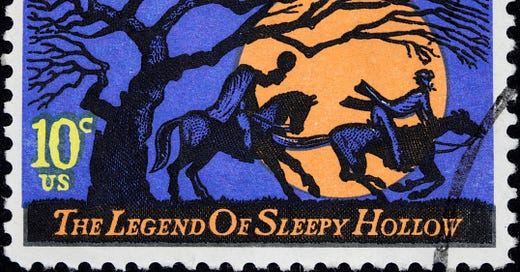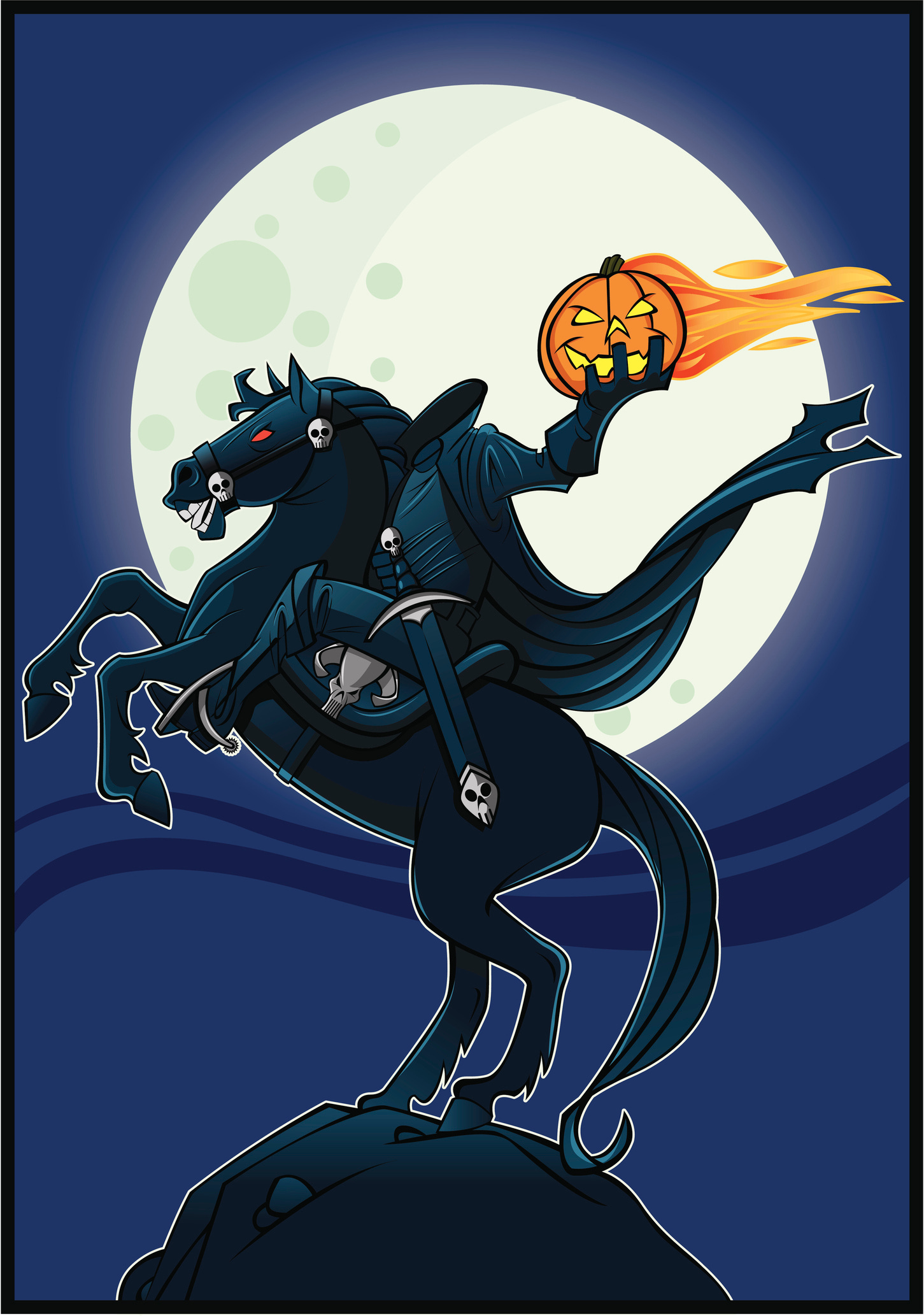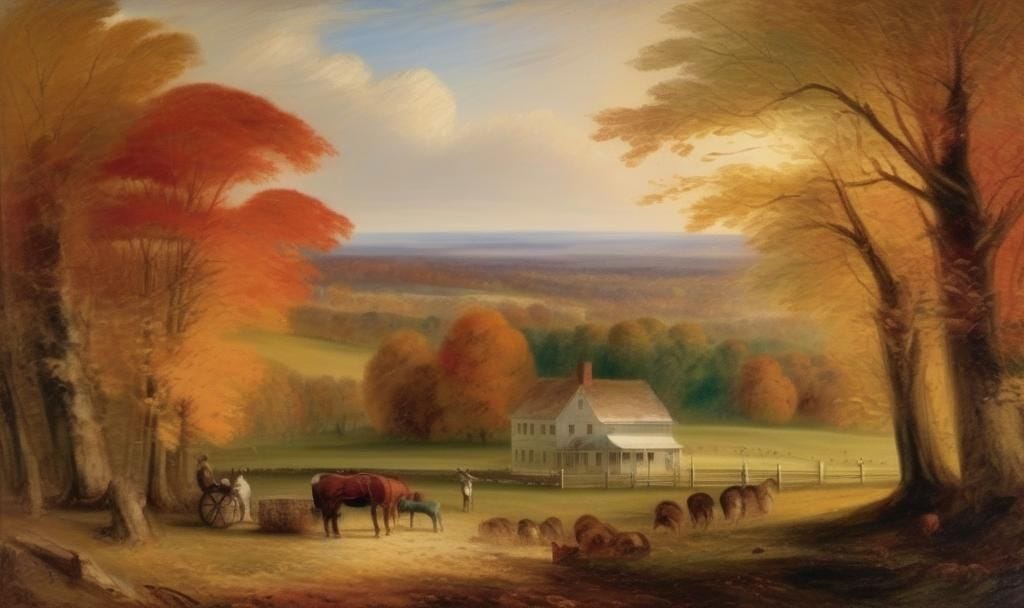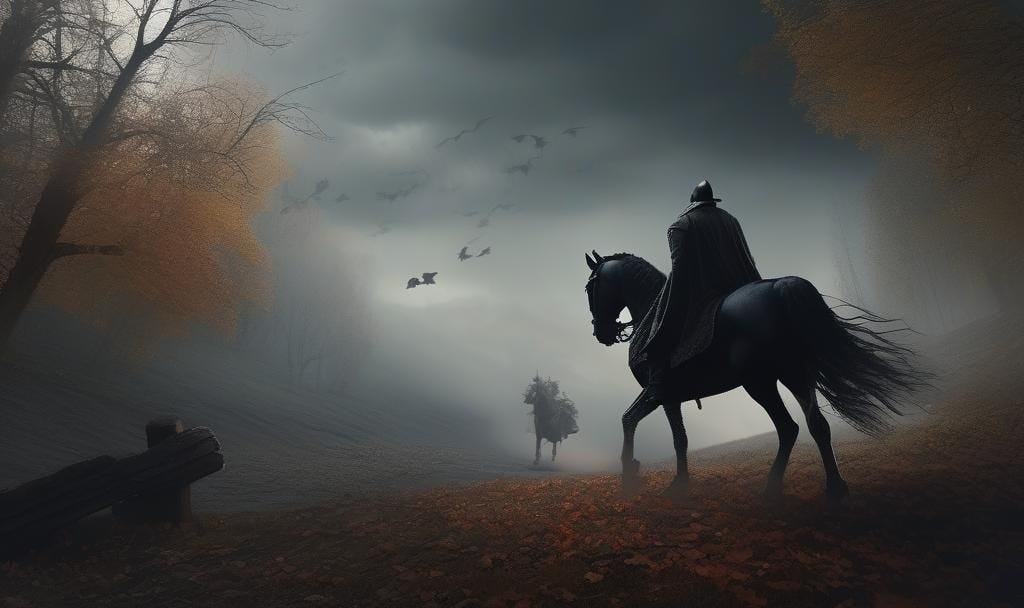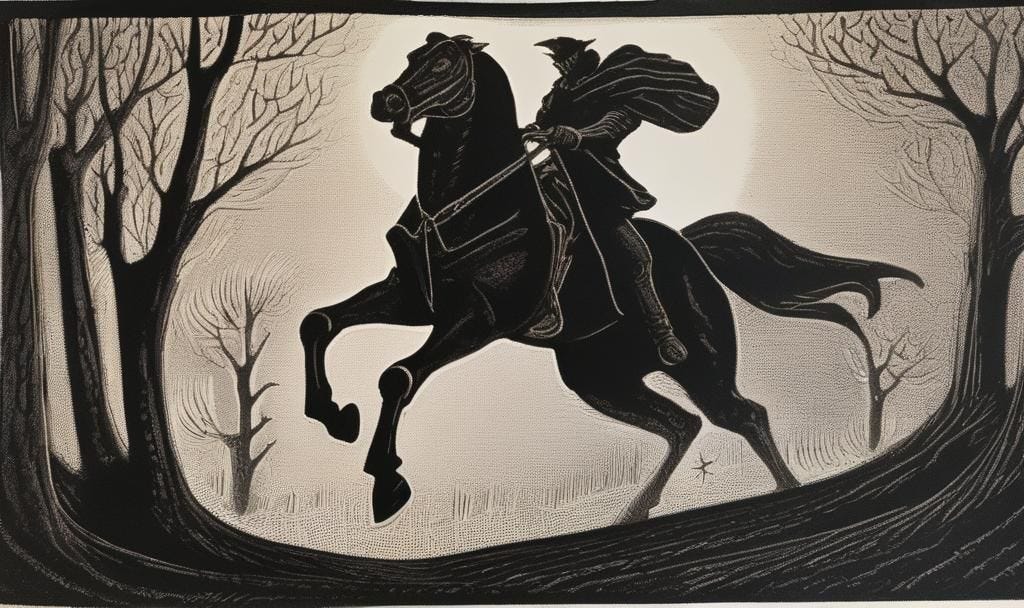Fairy Tale Truths: The Legend of Sleepy Hollow
A teacher, a pumpkin and a headless horseman
Quick - do you recognize this song?
“Don’t stop to figure out a plan,
You can’t reason with a headless man!”
These two lines, sung in Disney’s cartoon adaptation of The Legend of Sleepy Hollow, pretty much sum up the point of Washington Irving’s classic short story. Mixing folklore with history, this story tells the tale of an ambitious schoolteacher, a sleepy, superstitious town, and a terrifying ghost from the past. It makes its appearance every October, sharing the fate of one Ichabod Crane, the local schoolteacher to the children of the village of Sleepy Hollow in New York state. Fun fact - there was an actual Col. Ichabod B. Crane “who was a contemporary of Irving in the Marines,”1 who enlisted in 1809.
The tale itself was written in 1820 and is considered to be one of America’s first ghost stories.
Let’s visit this little hamlet for ourselves and read the story through the Four Senses.
1. Literal Sense: What does the story say?
Irving introduces us to the village of Sleepy Hollow by describing the natural world around it. He says a “drowsy, dreamy influence seemed to hang over all the land, and to pervade the very atmosphere.”2 It was as though time simply skipped over this little valley, leaving the inhabitants largely untouched. Before we even meet Ichabod Crane, we know that “certain it is, the place still continues under the sway of some witching power that holds a spell over the minds of the good people, causing them to walk in a continual reverie.” Not only that, but the whole area is full of ghost tales. A spirit lurks behind every bush and is ready to meet a late traveler at every bend in the road. This haunted belief is so prevalent that it will take hold of every person who tarries in the area. They will “begin to grow imaginative - to dream dreams and see apparitions.”
But of all the ghosts and goblins in the area, the most feared is the dreaded Headless Horseman. Many of the villagers swear and declare that they have seen him thundering down the country roads late at night, and he seems especially intent on making it to a certain country church cemetery where, it is presumed, his body is buried. It is widely believed, in that small hamlet, that the power of the Headless Horseman ends at the bridge before the churchyard where he reposes.
Into this situation wanders Ichabod Crane, a man whose last name describes him well. He is “tall, but exceedingly lank, with narrow shoulders, long arms and legs, hands that dangle a mile out of his sleeves, feet that might have served for shovels, and his whole frame most loosely hung together. His head was small and flat at top. with huge ears, large green glass eyes, and a long snipe nose.” To see him from a distance, people had to look twice, in case it was a scarecrow escaped from a nearby cornfield.
But what Ichabod lacks in physique, he makes up for in ambition. Although he is frequently the butt of the joke for the local lads, he makes inroads with the families of his students who he stays with, rotating among them each week. He rules over his small classroom carefully and, because of his position as schoolmaster, is considered to be “learned,” lower in rank only to the local parson. Ichabod is especially well-versed in one particular book, “Cotton Mather’s History of New England Witchcraft, in which, by the way, he most firmly and potently believed.” Between teaching and supplementing his income with singing lessons, life is fairy placid and Ichabod makes his way along “tolerably enough,” despite the occasional bump from the leader of the local boys, Brom Bones.
Brom Bones is a young man who is Ichabod’s opposite. Brom is active, physically well built, and not interested in the intellectual life at all. He’s also given to pranks, madcaps and mischief, although Irving lets us know that there is no “malice in his mischief.”
The stage is set for a blowup, though, when Ichabod and Brom Bones fall for the same girl, Katrina von Tassel. Katrina is the much-loved and only daughter of one of the wealthy farmers in the neighborhood, Mynheer von Tassel, and the two young suitors spend their days trying to curry her favor, so much so that a “deadly feud gradually arose” between them. But it all comes to a head the night of a “merry-making,” a party at Old Von Tassel’s farm.
After hours of dancing, drinking and feasting, the guests assemble around the fire to swap ghost stories, a favorite pastime of the small community. As the night grows late and the guests depart, Ichabod makes his lonely way back to the farmhouse where he is staying that week. Having just heard all of the local ghostly legends, his imagination is on high alert, and he is convinced he is not alone on his solitary journey in the dark. He knows he is drawing near to the favorite haunt of the Headless Horseman, and eyes the church and the bridge before it with grim anticipation. Once he crosses the bridge, he will be out of harm’s way.
But as he draws near, Ichabod “beheld something huge, misshapen and towering. It stirred not, but seemed gathered up in the gloom, like some gigantic monster ready to spring upon the traveler. The hair of the affrighted pedagogue rose upon his head with terror.”
Ichabod now does his best to outrun and escape from the great black steed and its unknown rider. The two horses dash around, treating their riders to a high-speed, heart pounding chase until finally, they reach the church bridge. “Old Gunpowder sprang upon the bridge; he thundered over the resounding planks; he gained the opposite side; and now Ichabod cast a look behind to see if his pursuer should vanish, according to the rule, in a flash of fire and brimstone. Just then he saw the goblin rising in his stirrups, and in the very act of hurling his head at him. Ichabod endeavored to dodge the horrible missile, but too late. It encountered his cranium with a tremendous crash, —he was tumbled headlong into the dust, and Gunpowder, the black steed, and the goblin rider, passed by like a whirlwind.”
The next morning, old Gunpowder was found wandering outside his farm, without his saddle, and Ichabod’s hat was discovered at the bridge, next to a “shattered pumpkin.” But the schoolmaster was never seen again. A rumor persisted that Ichabod had simply left the area, as the terror of the apparition and the rejection by young Katrina had proved too much. But according to someone who later passed through Sleepy Hollow, Ichabod had turned his life around; had studied law, passed the bar, become a “politician; electioneered; written for the newspapers; and finally, had been made a justice of the Ten Pound Court.” Ichabod had triumphed; there was a happy ending.
But this didn’t sit well with the inhabitants of Sleepy Hollow. Most believed that he had been spirited away by the Headless Horseman. His ghost has been seen wandering around his old schoolhouse, declare some young lads, and they swear they’ve heard his voice chanting a tune that wafts over the “tranquil solitudes of Sleepy Hollow.”
2. Spiritual Sense A - Allegorical: What does the story mean?
In this delightful tale, Irving brings up the relationship between work, the Imagination and Reason. All three are more than simply abilities that we can do. They are part of the gifts we are given because we are made in the image of God, and each should be ordered towards something higher, towards transcendental, divine reality. Work should be oriented towards building the highest good, the kingdom of God. Reason, meaning logical, propositional thought, and Imagination, referring to intuitive, generative apprehension, should both work together to bring true, real understanding. When all three are combined, there is Wisdom, specifically the Wisdom of God described in the Old Testament. The work of our hands, hearts and minds cooperate and participate together. When this happens, there is integrity of intention, purpose and meaning.
We know that the town of Sleepy Hollow is high in the Imagination category. The villagers are drowsy and live a world where the supernatural is around every corner. They mark time through the movements of the natural world, the sun in the sky and the turning of the seasons, instead of by the clock, through the ticking of seconds and minutes. Because of this, they are close to nature, seen in the surround farmlands and typical work that is usually done, which centers around working the earth. Everyone is comfortable with integrating work and Imagination, but they are not too interested in Reason, in well-ordered thinking.
Ichabod, although an outsider, is also naturally interested in the ability of the Imagination to give meaning to life. He arrives in Sleepy Hollow with his own copy of The History of New England Witchcraft, an unusual choice for a schoolmaster, a person who is supposed to be a man of letters, a person of propositional, rational logic who can impart the ability to reason to his pupils. Because he has not disciplined his mind and trained it to ponder higher things, Ichabod falls prey to the oldest trap in the book - reward without work. Although he does notice the lovely Katrina the first time he sees her, she becomes absolutely irresistible once he beholds her wealthy father’s fruitful and abundant lands. Iving writes:
As the enraptured Ichabod fancied all this, and as he rolled his great green eyes over the fat meadow lands, the rich fields of wheat, of rye, of buckwheat, and Indian corn, and the orchards burdened with ruddy fruit, which surrounded the warm tenement of Van Tassel, his heart yearned after the damsel who was to inherit these domains, and his imagination expanded with the idea, how they might be readily turned into cash, and the money invested in immense tracts of wild land, and shingle palaces in the wilderness. Nay, his busy fancy already realized his hopes, and presented to him the blooming Katrina, with a whole family of children, mounted on the top of a wagon loaded with household trumpery, with pots and kettles dangling beneath; and he beheld himself bestriding a pacing mare, with a colt at her heels, setting out for Kentucky, Tennessee, —or the Lord knows where!
It’s natural for a poor, itinerant teacher like Ichabod to want to secure a more comfortable and more stable income. But Ichabod, actually, will not be satisfied with Katrina’s great wealth. Instead, he intends to sell up and go west, to find a place where he is not simply secure and comfortable, but legendary. That he intends to chase this dream using the wealth of Katrina’s family, likely built up over generations of hard, backbreaking work, does not seem to enter Ichabod’s rather empty head.
3. Spiritual Sense B - Moral: How does the story teach us to act?
If we return to the origins of the Headless Horseman, we learn that most of the Sleepy Hollow folk believed he was originally a Hessian soldier whose “head was carried away by a cannonball” in one of the battles of the Revolutionary War. He rides out at night to find a new head, since this is apparently what he needs to be able to finally rest. Of course, this is an impossible task. In the meantime, he makes do with a flaming Jack o’ Lantern substitute, which he hurls at unsuspecting folk. Did the Headless Horseman entertain illusions (or rather delusions) of grandeur in life, just like Ichabod? Is that the real reason why he rushes about, desperately seeking his head? Ichabod, and the Headless Horseman as well, are not using their Imaginations properly. They are indulging in Fancy, in daydreams that don’t hold up in the light of day because they are not self-sacrificing but are self-serving. Imagination and Reason are complementary and can be formed, purified and refined. Fancy, however, is just along for the ride.
In contrast to these two, St. Paul reminds us to “be transformed by the renewing of the mind.” (Romans 12:2) This is pointed towards a specific goal, to “discern what is the will of God, what is good and pleasing and perfect.” This verse is explained by saying:
Christians are liberated for the exercise of good judgment as they are confronted with the many and varied decisions required in the course of daily life. To assist them, God distributes a variety of gifts to the fellowship of believers, including those of prophecy, teaching, and exhortation (Rom 12:6–8). Prophets assist the community to understand the will of God as it applies to the present situation (Rom 12:6). Teachers help people to understand themselves and their responsibilities in relation to others (Rom 12:7). One who exhorts offers encouragement to the community to exercise their faith in the performance of all that is pleasing to God (Rom 12:8)3
Doing the labor to form and train our minds is important. It takes effort. It takes work. Just as an athlete knows it takes effort to train his or her body to perform well, so, too, should we take seriously the call to form our minds so that we can discern the will of God and put it into action.
4. Spiritual Sense C - Anagogical or Eschatological Sense: How does the story point us forward, to our end?
The warning of The Legend of Sleepy Hollow is pretty straightforward. It reminds us that there are eternal repercussions for what we value in this life. What we spend our time on in this life, what we ponder and daydream about, those things we secretly desire in our hearts, reveal what we will become in the next life. Perhaps another reason the Headless Horseman wanders is because he lost his head often when he was alive - he lost his temper and exploded at others when he was in the flesh. Now, he “loses his top” in the afterlife, even throwing his pumpkin-head at the living. What can be done with a person like this? Not much. As the song says, “Don’t try to figure out a plan, you can’t reason with a headless man!”
Ichabod spent his time daydreaming of the good life, of a life of ease. If he became that ghost wandering around the schoolhouse, he most certainly has found a life free from the work he was called to do in life. Now, he drifts idly around the site where he once had the privilege of educating young minds.
But perhaps he did heed the warning of the Headless Horseman that he was given on that lonely autumn night and went in the opposite direction. Perhaps he really did buckle down, do the hard work, and discipline his mind and his relationships so that he could eventually become a noble politician and a just judge. We might ask ourselves the same questions: How do I spend my leisure4 time? What do I daydream about? And do I use my Reason and Imagination together to do the work I have been given, the task that only I can complete?
What Inspired 'The Legend of Sleepy Hollow'? | HISTORY
Sleepy Hollow, 279
Romans, CHAPTER 12 | USCCB
The word leisure has a long history and has nothing to do with distraction and idleness. Our word, school, comes from the Lain word schola, which is a translation from the Greek word, Scholé. Scholé was the Greek word for ‘leisure.’


